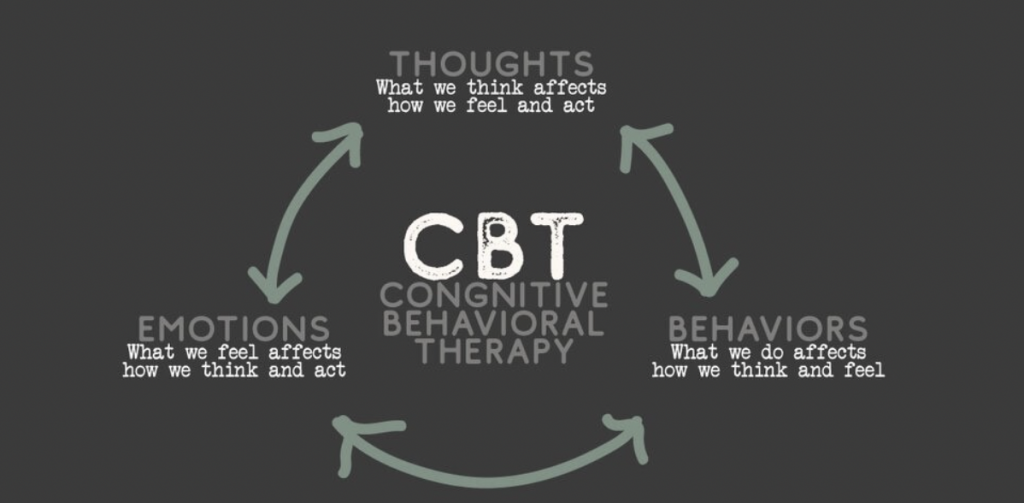
Cognitive Behaviorial Therapy
Cognitive Behavioral Therapy (CBT)
Cognitive Behavioral Therapy in plain language is thought-behavior therapy. The goal is to understand how the interplay of contexts, cues, thoughts, emotions, and behaviors interact in complex ways. Within CBT there are a plethora of tools and techniques to help guide the process (look up thought logs, behavioral chain analysis, and progressive muscle relaxation techniques).
As an approach, CBT works very well for some and not so much for others. We are great at collaborating with you and determining the best way to approach your specific challenges. Those that tend to do well with CBT enjoy a more structured, homework-oriented, goal-directed, and non-exploratory approach to treatment. Ironically, some that are immediately drawn towards this treatment often benefit more from a psychodynamic approach. Using a rigid therapy for trouble with rigidity often compounds the problem. This is important to discuss with your psychologist. Getting in touch with lost parts of the self that are more creative, flexible, and spontaneous require a different treatment method and still solve the problem but leave a more balanced personality in the end too.
CBT is the most amenable theoretical orientation to research (because it is easily manualized) and as a result has become one of the most empirically supported approaches to therapy.
Its focus is on thoughts and specifically how deeply intertwined patterns of thinking and feeling co-operate together and influence behavior and overall mental health. As a result of experience, we can develop unhealthy thought-reflexes or as CBT calls them “automatic negative thoughts” or ANTS. Generating these patterns are often deeply hurt parts of us that need our loving attention. The wounds at the center are called “Core Beliefs” in CBT. Overall, the goal is to expose and process this core while promoting insight and change into unhelpful thoughts patterns and behaviors.
Common cognitive distortions targeted in a CBT approach are:
- All or nothing thinking/Polarized thinking
- Overgeneralization
- Mental Filter
- Disqualifying the positive
- Jumping to conclusions – mind reading
- Jumping to conclusions – fortune telling
- Magnification (catastrophizing) or Minimization
- Emotional Reasoning (I feel it, therefore it must be true)
- Should Statements
- Labeling and Mislabeling
- Personalization
- Control Fallacies (how much control, or not, we have over things)
- Just world fallacy or the fallacy of fairness
- Fallacy of Change (expecting others to change)
- Belief we must always be right
- Belief that our suffering and hard work will always result in a just reward
General goals of a Cognitive Behavioral (CBT) approach include:
- Recognizing distortions in thinking that are amplifying problems or unhealthy emotions/emotional states
- Re-evaluating thinking patterns to try and make them more balanced and in-line with reality
- Using problem-solving skills to cope with difficult situations
- Identifying and creating interventions to decrease automatic negative thoughts
- Learn to develop a greater sense of confidence in one’s own abilities
- Facing fears directly and with an effective mindset
- Learning skills to calm one’s mind and body
Research shows CBT is helpful to (Mayo Clinic, 2022):
Manage general symptoms of mental illness or prevent a relapse of mental illness symptoms
- Treat a mental illness when medications aren’t a good option
- Learn techniques for coping with stressful life situations
- Identify ways to manage emotions
- Resolve relationship conflicts and learn better ways to communicate
- Cope with grief or loss
- Overcome emotional trauma related to abuse or violence
- Cope with a medical illness
- Manage chronic physical symptoms
Mental health disorders that often improve with CBT include (2022):
- Depression
- Anxiety disorders
- Phobias
- PTSD
- Sleep disorders
- Eating disorders
- Obsessive-compulsive disorder (OCD)
- Substance use disorders
- Bipolar disorders
- Schizophrenia
- Sexual Disorders
Frequently Asked Question
Psychodynamic therapy is a depth-oriented form of therapy aimed at targeting root issues. Its focus is on how patterns of our early environments are cemented into our adult styles of work, love, and play.
Psychodynamic therapy is a powerful, transformative type of therapy that helps people process emotions and develop insight at the deepest level. It relies on decades of research from master clinicians in psychoanalysis and attachment therapy. This is a unique and highly effective specialty of our group.
Psychodynamic therapy is all about processing emotion and developing insight. We collaborate with you in unearthing core memories and experiences in your life and drawing important connections to the challenges and suffering you are currently facing. You can expect major “aha!” moments and healing in some of the deepest ways therapy has to offer.
The available research shows enormous benefits to this form of therapy. In fact, the literature on psychodynamic therapy supports some of the most effective and long-lasting change possible. It is effective at treating anxiety, depression, relationship issues, attachment disorders, obsessive compulsive disorder (OCD), addiction and trauma.
Our clients frequently share that this approach is different from anything they had experienced before and believe it to be a significant part of their change process and healing.
A fellow psychodynamic psychologist has written several engaging articles on the effectiveness of this approach, you can find them here:
Yes! We are one of the few groups in the area that specialize in this type of therapy. We believe this is the secret sauce of our group and one of the reasons we have such a positive reputation for providing quality, life-changing therapy. Reach out to us if you would like to find out more about this approach.
First, you’ve found one! Some other great ways to search for psychodynamic therapists near you is on Psychology Today or one of the local Psychoanalytic professional communities in the area.
One of the things that I encourage patients seeking therapy to do is look for reviews, personal experiences, and ask a prospective therapist if they practice this form of therapy specifically.
The key principles of psychodynamic therapy are:
- A focus on affect and expression of emotion and putting words to feelings
- Exploration of attempts to avoid distressing thoughts and feelings – this is often much more complicated and sneakier than what appears on the surface or what one knows about themselves already.
- Identification of recurring themes and patterns – particularly one’s defensive patterns and personality styles aimed at avoiding threatening emotions
- Discussion of past experience – identification of recurring themes in relating to others, particularly early attachment figures, that manifest in one’s thoughts, feelings, relationships, and self-concept).
- Focus on Interpersonal relationships past and present – this is often where the breadcrumbs lie that take us to the issues that really need to be dealt with.
- A focus on the therapeutic relationship – the patterns that are a part of one’s relational/emotional history are likely to emerge in the patient-therapist dynamic. This is all grist for the mill and identifying these “reenactments” are often a powerful part of the process.
- Exploration of fantasy life – we encourage our patients to free-associate and allow themselves to speak freely, in an un-editing way during our sessions, this is often an incredible gateway to identifying deep psychological issues and conflicts.
A long-term commitment isn’t necessary. We encourage our patients to take it a session at a time before deciding to be all-in or all-out. The answer to this question becomes more obvious after the first few sessions after the depth and breadth of issues come into plain sight for both therapist and patient. However, we are very strict on session attendance meeting the standard of care, once per week. Any less and it’s just too difficult to go into depth on anything and the therapy becomes more of a check-in than a change process.
Of course! We encourage patients to do their own research and read reviews on the therapists they are interested in. Ours can be found on both our Google, Yelp, and Healthgrades pages. We think it’s especially important that anyone practicing psychodynamic therapy has actually done this type of therapy themselves. This is the case for us and we believe it is an art best learned through experience.
This is a great question! We like to make this question more of a conversation than give a blanketed reply. Some of the other therapies we offer are Cognitive Behavioral Therapy (CBT) and Emotion Focused Therapy (EFT).
We typically use elements of each in tandem with other therapeutic approaches. Anything too stiffly implemented creates a rigid, ineffective therapy. However, most therapies tend to lean more on certain therapeutic approaches over others given the clients personality, goals, and clinical issues.
We would love to discuss who in our group would be a best fit and which approach you would likely benefit from. Give us a call!

